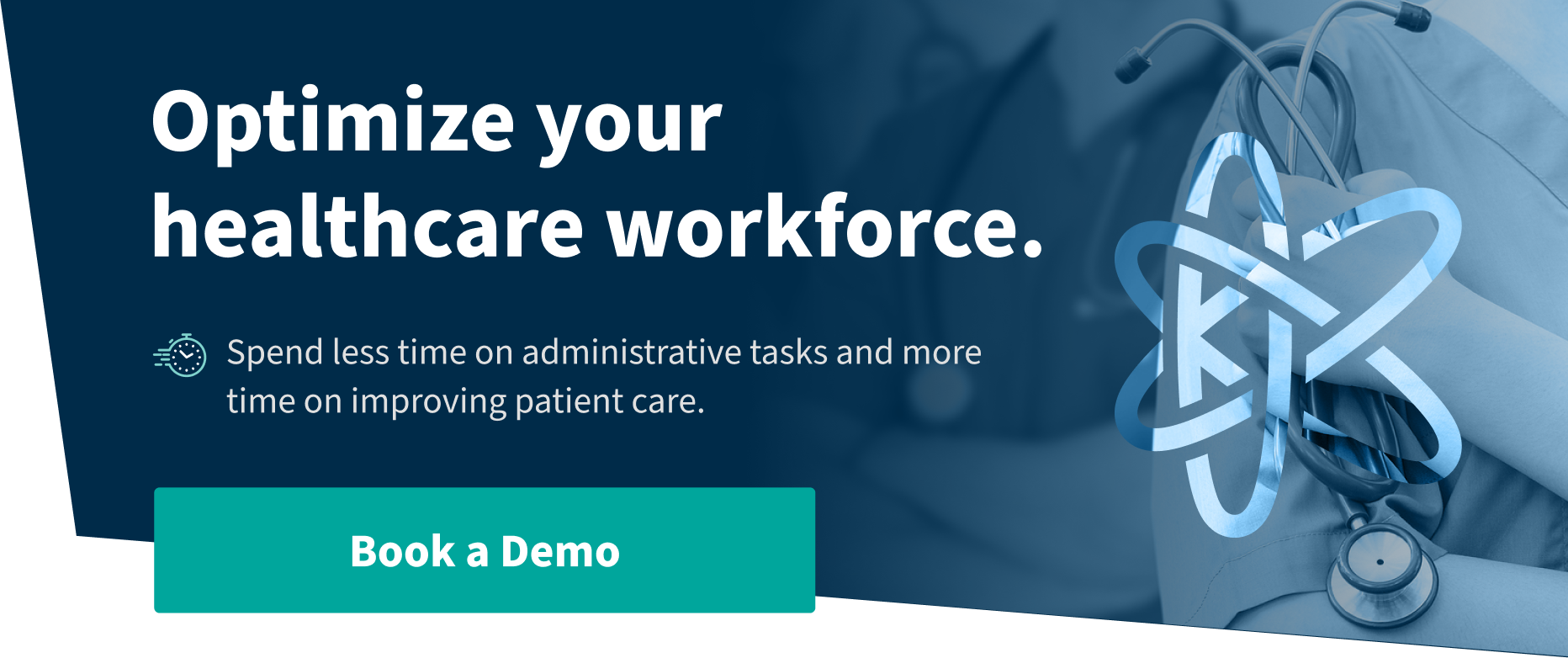The healthcare workforce is the lifeblood of any health system. Yet healthcare organizations often struggle to build strong relationships and alignment across their expansive network of physicians, clinicians, support staff, etc...
From saving money to improving team member morale (i.e. reducing burnout), how you handle your workforce management can be the difference between HCOs that merely survive and ones that thrive.
Key aspects of managing your workforce include:
- Centralized tracking of provider information: Their credentials, privileging status, pay rates, employment details etc. This allows scheduling the right providers at different facilities based on their qualifications.
- Management of onboarding workflows: Application tracking, credentialing, document collection etc. Automates tedious paper-based processes.
- Visibility into provider availability and shift scheduling across different locations to enable better capacity planning and shift fill rates.
- Integration and syncing workflows between different teams (recruiting, credentialing, scheduling etc) to eliminate manual coordination. Provides a "single source of truth".
- Performance tracking and analytics: Time-to-fill metrics, cost metrics, shift cancellation rates etc to enable data-driven decision making and vendor accountability.
- More accurate budget forecasting thanks to streamlined shift confirmation, invoicing and payment processes for temporary/contracted staff.
In summary, WRM aims to centralize and automate the currently fragmented systems and processes for healthcare staffing and scheduling across complex multi-entity environments. The goal is to drive efficiency, lower costs, and improve workforce utilization.
Strategies You Might be Able to Use to Improve Employee Engagement and Satisfaction within HCOs
Quality caregivers are the heart of healthcare - they strive to provide exceptional care and service. However, high turnover disrupts continuity of care. Backfilling quality staff is time-intensive. If you hope to ensure your employees are engaged and satisfied, there are a few things you can do.
The first and perhaps most important is to provide opportunities for growth. This can be handled with things like:
-- Training
-- Mentorship programs, and
-- Clear paths for advancement
When we are motivated, we’re more likely to build out our skills and advance our careers.
Make sure your door is always open for feedback from staff, partners, leadership, etc… Your people want to be heard.
Regardless of how small or big an achievement is, it’s also a good idea to recognize and reward your people when goals are achieved. It’s great for boosting morale in your organization.
As difficult as it may feel, you might also want to consider promoting a balance between work and life. This can be handled with flexible scheduling and reasonable workloads wherever possible. And, make sure your team knows about mental health resources should they feel they need additional support.
Overall, you want to build a positive workplace culture while still maintaining your organization’s values. At the same time, it’s important to understand your team will want fair and competitive wages and benefits packages. Address their needs, and your own, but communicate every step of the way and you will find you have a more satisfied healthcare workforce.
With comprehensive engagement strategies addressing culture, communication, and tools for efficiency, you have a much better chance at keeping quality caregivers satisfied in their vital roles delivering exemplary care.
HCO Tips for Effective Communication
Effective communication is absolutely vital in healthcare, yet often poses challenges with various professionals across different departments and roles. My advice is to establish centralized, digital channels that create transparency and streamline messaging.
For example, implementing team communication software where staff can broadcast questions, share documents, and collaborate virtually. Set expectations that inquiries will be addressed within a certain timeframe, like 24 hours, so no one feels ignored. Schedule brief, standing team meetings to regularly sync up.
Lead by example in being responsive, and keep conversations professional yet approachable so everyone feels comfortable participating. Promote face-to-face check-ins when possible as well. Also, integrate systems so patient data, schedules, and workload metrics are accessible to the right parties in real-time.
Removing information silos enhances coordination of care. The key is combining human interaction with technology to nurture a culture of open, timely communication – both digital and interpersonal. This ensures care teams stay connected to provide the best patient outcomes.
Tips to Reduce Burnout Among Healthcare Teams
Healthcare professionals face immense pressure delivering lifesaving care. Organizations must take proactive steps to support wellbeing and reduce burnout. First, offer flexible scheduling and remote work to provide more work-life balance. Discourage overwork and unreasonable on call burdens. Implement programs to help manage stress and mental health issues confidentially. Train leadership to spot signs of burnout. Conduct engagement surveys to identify pain points. Review workloads and hire additional staff if needed. Set up peer support systems for employees to connect. Provide quiet rooms for breaks. Reward success and remind staff of the incredible good they do. With comprehensive wellbeing strategies addressing workload, culture, support resources and recognition, organizations can boost resilience and sustain passionate teams.
It’s also worth noting that there has been a massive increase in the turnover rates for both nurses and physicians. With the nursing and physician shortages reaching crisis levels, quality caregivers are leaving their positions in droves. This mass exodus exacerbates issues from patient safety risks to soaring labor costs. Turnover stems largely from burnout. Organizations must better engage their team members and reimagine how to retain top talent. Here are some ideas that may help with this:
Renew focus on professional development for both nurses and physicians. Through continuing education support and career ladder programs, you can highlight paths to advanced roles like nurse practitioner or lead physician to help team members maintain passion.
Prioritize mental health and wellbeing by providing access to confidential counseling, wellness workshops, and bereavement resources. Ensure manageable nurse-patient and physician-patient ratios.
Gather regular feedback on workload and culture. Adjust scheduling and responsibilities based on input. Recognize outstanding nurses and physicians publicly.
Offer incentives like student loan repayment and retention bonuses. Benchmark compensation against regional competitors to remain attractive.
Create peer mentorships between experienced and new team members. Invest in next-gen nurse preceptors. Revive the spirit of teamwork and community.
Encourage participation in committees and decision-making to give your nurses and physicians greater autonomy and voice.
Provide the latest tech tools that make healthcare workflows more efficient, like automated documentation and virtual rounding platforms.
With comprehensive engagement strategies, organizations can slow the loss of irreplaceable healthcare team members knowledge and rebuild a satisfied, empowered workforce.
Help Healthcare Workers With Ongoing Training and Development Opportunities
For healthcare workers to provide excellent care amid constant industry evolution, ongoing training and development is essential. To assist with this, you can:
- Require annual continuing education on new protocols and best practices, and budget paid time for it.
- Encourage pursuit of advanced certifications through tuition assistance.
- Identify high performers for leadership training to retain talent.
- Build relationships with academic medical centers to access cutting edge research.
- Enable job shadowing across departments to fuel growth.
- Hold “lunch & learn” events for staff to share emerging trends.
- Appoint team members as specialists who digest literature and advise others.
- Invest in digital learning platforms with microlearning.
Bottom line - Make professional development a consistent, funded priority woven into daily workflows, and healthcare teams will maintain the skills to deliver leading-edge care.
Insights on Managing a Diverse Workforce in Healthcare
In healthcare, a diverse and inclusive workforce enables higher quality care and outcomes. A few ways to help you ensure your HCO is diverse include, but aren’t limited to:
- Organizations should start by auditing hiring practices for unconscious bias and interview fairly.
- Provide cultural competence and anti-racism training.
- Review workplace policies, facilities and culture for accessibility and acceptance of all people.
- Support employee resource groups where minorities can find community.
- Leverage diversity when forming project groups.
- Regularly collect input from minority staff on the inclusion climate with action plans for growth.
- Actively listen when issues are raised. Set equitable policies around family leave and religious needs.
- Challenge limiting assumptions about “fitting in.” Promote diverse leaders as role models.
When everyone feels welcomed, respected and heard, the entire organization thrives.
How Can You Get Feedback From Healthcare Employees to Improve Workforce Relationships and Processes?
Regular employee feedback provides invaluable insights to strengthen workforce relationships and refine processes. There are several ways to get feedback. A few of which are:
- Conduct anonymous engagement surveys annually.
- Seek suggestions in team meetings.
- Assign peer advisors as safe contacts.
- Monitor workplace review sites.
- Leverage pulse surveys for timely input.
- Require leaders to gather 1:1 feedback quarterly.
- Evaluate exit interviews for shared themes.
- Create an anonymous digital channel for ideas.
- Thank participants for honesty.
- Distill common themes and present action plans, closing the loop. Share highlights across the organization.
- Use software analytics on workflows to identify bottlenecks.
With multifaceted feedback via human connection, technology, and impartial audits, organizations gain an accurate picture for growth.
Align HCO Workforce Goals with Your Organization's Mission to Provide High-Quality Patient Care
In healthcare, aligning workforce goals with patient care excellence starts with an inspiring mission statement centered on compassion, quality and safety. Establish metrics on patient outcomes, and track them visibly alongside financials. Showcase provider impact stories. Tie incentive plans to care about KPIs, not just revenue. Conduct whole-team briefings on adverse events to collectively improve. Enable staff volunteer hours supporting community health. Set expectations for patient-first mindsets during onboarding. Keep policies patient-focused, like family visitation. Schedule rotations for cross-departmental insight. When every worker understands their role in the care journey, individual goals become unified around common purpose – exceptional patient experiences.
How to Measure the Effectiveness of Workforce Relationship Management Initiatives
To gauge Workforce Relationship Management efficacy, start by determining key performance indicators. Relevant metrics may include:
- Turnover/retention rates,
- Days to fill positions,
- Training hours per employee,
- Utilization of self-service portals
- Scheduling efficiency stats
- Credentials expiry rates, and
- Overtime/agency spending
Compare employee net promoter scores over time and against industry benchmarks. Monitor platform user activity and workflow enhancement projections. Survey stakeholders on engagement. Quantify time savings from digitized processes. Track compliance with labor regulations. Build an integrated analytics dashboard. When you align metrics with relationship goals, organizations gain clear visibility into the health and trajectory of their workforce. Continuous improvement is possible by leveraging data insights.
How Kimedics WRM Can Help You Address Scheduling Challenges
A workforce relationship management platform like Kimedics can help address scheduling challenges and enable more fair and equitable distribution of work assignments in several ways:
- Centralized visibility into provider availability and credentials across all facilities makes it easier to identify and assign the best providers to open shifts. This leads to improved shift fill rates.
- Automated shift dispatch based on predefined rules (seniority, utilization rate, skills etc) ensures more fair and equitable distribution rather than manual assignment.
- Performance tracking by provider enables monitoring of work allocation over time to ensure equal opportunities. Analytics can identify any outliers or inconsistencies.
- Open shift postings to all qualified providers, including external/contractors, ensures equal visibility of work opportunities for interested providers.
- Capacity planning analytics takes into account provider schedules, credentials status, and availability leading to more realistic shift assignments and workload distribution.
- Rules engines and alerts around scheduling thresholds (maximum hours, minimum rest periods etc) prevents over scheduling or burnout.
In essence, the transparency, automation and analytics capabilities structurally enable more equitable work allocation and optimal utilization across a flexible provider workforce. Administrative biases can be reduced significantly.
Want to see what Kimedics can do for your healthcare organization? Click here to set up a free demo today!


